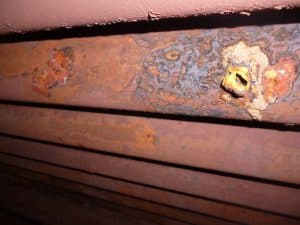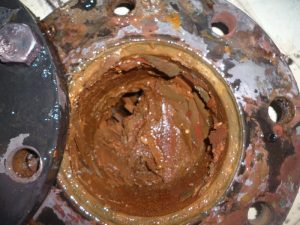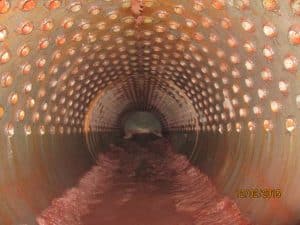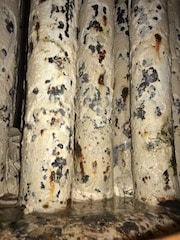Boiler scaling 
Scale buildup on the boiler fire tube
Sludge in boilers is classified as follows:
- The essential protective iron oxide layer (magnetite layer) is dark brown to black, very thin (<0.1mm), solid like a thin layer of rolled scales, this residue layer does not increase the temperature of the surface. heat exchange wall surface.
- Unwanted porous, gray or light brown scale made up of contaminants in the water (mainly hard scale or silica scale), which always increases the temperature of the exchange wall heat.
- The porous sediment layer, light brown to red brown, is a product of iron corrosion (mainly formed by the amount of iron in the boiler feed water (BFW)). This layer of sediment is almost unavoidable in the boiler system.
- Local blistering or peeling resembling scale due to corrosion caused by oxygen during furnace shutdown. A well designed boiler – vertical or horizontal fire tube and water tube – will achieve the expected life desired if and only if the boiler steel is capable of forming and retaining a magnetite (Fe3O4) layer, providing protection during operation and shutdown of the furnace. Unwanted scale due to water composition or corrosion products will increases furnace wall temperature. This temperature increase depends on the thickness, composition and porosity of the residue and can lead to overheating of the material, reducing its durability, damaging or exploding the boiler. Particularly dangerous are silica residues and residues containing oil or grease.
Corrosion in the furnace

Corrosion of boiler fire tube
The corrosion process in boilers is mainly electrochemical corrosion. This is a reaction between a metallic material and the environment that results in the material or structure being destroyed earlier than its normal lifespan.
The region where the metal corrodes and enters solution as a metal cation (such as Fe2+ ions) is called the anode.
The area where the surrounding environment is mostly water reacts with electrons from the anode, called the cathode.
For example, the reaction reduces oxygen (O2) to an OH- anion (oxygen corrosive form) or the H+ cation of an acid is reduced to a hydrogen atom (hydrogen corrosive form).
In boilers, corrosion is determined mainly by the different states of the protective magnetite layer (porous or solid layer), defects in the magnetite layer (e.g. cracking due to different stresses) or other conditions. Different aeration of the magnetite layer (such as above and below the sediment layer, above and below the waterline). It should be noted that the protective magnetite layer is more brittle and electropositive than steel.
The most common reactions in oxygen corrosion on iron or steel
Oxygen corrosion often leads to localized corrosion encountered during furnace shutdown (if pressure is zero and steam is replaced by air). This corrosion is similar to atmospheric corrosion of carbon steel.
Incipient oxygen corrosion often produces yellow-brown rust. Oxygen corrosion has occurred for a long time and when heated, the color is brown to dark brown. Conductivity increases as corrosion occurs.
Other forms of corrosion in low pressure boiler systems are:
– Acid corrosion due to carbonic acid in steam and condensate pipes,
– Abrasive corrosion or flow-induced corrosion (FAC) and erosion corrosion (cavitation) are both mainly influenced by flow conditions.
Corrosion corrosion results from the formation of vapor bubbles and their subsequent explosion directed against the pipe wall (clearly audible). For example, the top of the condenser tube contains a mixture of condensate and steam, or the pump is operating in hot water. Increasing the pressure at the pump inlet will overcome this phenomenon.
Water composition affects scale formation and boiler corrosion
Natural water (rainwater, river water, well water, tap water…) depends on its origin and contains very different compounds. The cleanest natural water is rainwater. All other types of water (like river water) contain insoluble substances and more or less dissolved substances such as hardness, silicon, iron, manganese, organic compounds, oxygen…
Below are some commonly used concepts to evaluate water quality. Common impurities in water, their effects and their risks to boilers are also explained.
Electrical conductivity affects boiler corrosion
The sum of all dissolved (conducting) substances in water can be determined through electrical conductivity (standard temperature is 250C).
Conductivity depends on temperature and conductivity increases as temperature increases, for example, at 250C the conductivity is 100μS/cm, then at 1000C it increases to about 440μS/cm.
(SI measurement system defines: S = 1Ω, where, S: Siemen; Ω: resistance; 1S = 1 000 000 μS). The conductivity of water is determined by dissolved substances such as salts, acids (including carbonic acid), bases and some organic substances, see figure 9, but silicon has no effect on the conductivity of water.
The substances dissolved in water mentioned above mostly dissociate into ions with different charges depending on their valence. Positively charged ions are called cations (like Na+, Ca++, Fe+++) and negatively charged are called anions (like Cl-, SO42-, PO43-). Even a very small portion of water dissociates into H+ cations and OH- anions, so pure water also has electrical conductivity. At 250C, pure water has a conductivity of about 0.055μS/cm, equivalent to a resistance of about 18.2 MΩ.cm = 18,200,000 Ω.cm!
In Asia, the conductivity of rainwater is about 10- 20μS/cm, that of river water (unaffected by seawater) is about 100- 300μS/cm, and that of well water or groundwater has similar values. The conductivity of brackish water can be up to 10,000- 20,000μS/cm.
Water conductivity affects corrosion; the higher the conductivity, the greater the corrosion rate
pH affects boiler corrosion
The very low dissociation of pure water determines the neutral pH value of 7, a pH lower than 7 is characteristic of an acidic environment with acidity increasing as the pH drops to 0, and a pH greater than 7 is characteristic of an acidic environment. basic (or alkaline) field with increasing alkalinity as pH increases up to 14. It should be noted that each step in pH results in a 10-fold change in concentration! For example, 0.4 mg/l of caustic soda (NaOH) in water will give pH = 9, water containing 4 mg/l of NaOH will give pH = 10, similarly with a solution of 40 mg/l, pH = 11 and 400 mg/l pH = 12. Caustic soda solution with a concentration of 1mmol/l is equivalent to 40 mg/l caustic soda (NaOH).
Water with moderate alkalinity (pH 9 – 12) is the ideal condition to protect iron from corrosion! Acid or acidic water will dissolve the protective magnetite layer and destroy the iron/steel.
Hardness is the main cause of boiler scale
Water hardness (mainly compounds of calcium and magnesium) is classified into carbonate hardness and non-carbonate hardness.
Carbonate hardness (calcium/magnesium bicarbonate) is a hardness that can only be dissolved in water with a small amount of carbonic acid (due to CO2 dissolved in water). If this amount of CO2 is removed by boiling or reduced by air spraying or heating, calcium carbonate (limestone) will precipitate and form carbonate residue.
Tropical and subtropical areas often have heavy rains so only little limestone is formed, so the carbonate hardness of raw water is relatively low.
Non-carbonate hardness (calcium/magnesium chloride, sulfate, nitrate…) can dissolve well in water, only calcium sulfate (gypsum) creates residue if its concentration is greater than 2g/l = 2000mg/l. Raw water contaminated by seawater or brackish water has high non-carbonate hardness because seawater has a very high NaCl content, even CaCl2 and MgCl2.
When there is silicon in the water (in the form of silicon acid, silicon oxide), both carbonate and non-carbonate hardness create calcium/magnesium silicate deposits (silica deposits) and reduce the heat transfer coefficient.
The easiest, safest and most common route to reducing water hardness is to apply a water softener, which transfers calcium and sodium compounds that are very soluble in water.
Alkalinity affects the rate of scale and boiler corrosion
Alkalinity is an important parameter during boiler operation, it allows determining the different components of water by titration with 0.1N acid when determining positive m/p alkalinity values and with bases. 0.1N when determining negative m/p alkalinity value. Alkalinity is classified into total alkalinity, mixed alkalinity, NaOH alkalinity.
Total alkalinity (positive m alkalinity) is the alkalinity caused by bicarbonate (e.g. from carbonate hardness or sodium bicarbonate (reaction product of carbonate hardness during water softening), it includes mixed alkalinity (positive alkalinity p) and NaOH alkalinity if available.
If the water only has positive alkalinity, it means the water only contains bicarbonate (such as carbonate hardness or NaHCO3), this is the basic characteristic of raw water or water after softening.
If water has negative alkalinity, it represents an acidic environment with a pH lower than 4.3 and is determined by titration with 0.1N NaOH.
Mixed alkalinity (positive p-alkalinity) is caused by all alkaline compounds with pH > 8.2 such as carbonate (soda), Na3PO4 and free alkalis (such as caustic soda NaOH), and it replaces the measurement of NaOH alkalinity. Mixed alkalinity includes NaOH alkalinity.
Negative alkalinity p value (- p) indicates pH < 8.2 and represents a weakly alkaline or acidic medium, it is determined by titration with 0.1N NaOH.
NaOH alkalinity only indicates the free alkalinity content in water but it needs to be determined according to a special procedure before titration to determine alkalinity p (phenolphthalein indicator).
The indicator used when determining alkalinity is methyl orange, it changes color at pH = 4.3. The indicator used when determining alkalinity p is phenolphthalein, it changes color at pH = 8.2.
This means that water is only alkaline when it has an alkalinity p value. Transition between negative/positive alkalinity p, negative/positive alkalinity m, pH and indicator change range
For horizontal boilers, it is necessary to check the mixed alkalinity p and total alkalinity of the boiler water.
Silicon creates boiler sludge
Countries in the tropics and subtropics often have heavy rain, and raw water often contains silica (silicon oxide) and/or silicates (compounds of silicon with calcium, magnesium, aluminum, such as silicon aluminum: clay) from medium to high, especially river water after heavy rain. Both silicon and silicates originate from underground minerals such as granite, mica, clay, basalt…, because limestone is almost completely soluble in rainwater.
Silica and silicates can exist in soluble or semi-soluble (colloidal) forms and are difficult to eliminate or reduce by water treatment. Mechanical filtration and water softening cannot remove silica and silicates.
The solubility of silicon oxide (SiO2) in water increases sharply with temperature and alkalinity. In neutral or weakly alkaline water its solubility is very low, so a silica scale will form.
Silicates are almost insoluble in water, except for alkaline silicates (Na and K), so if in an environment without phosphate, both silicate and hardness are present at the same time, silicate residue will form.
Iron and manganese create boiler deposits

The residue clogs the boiler blowdown line
Compounds of iron and manganese are always present in surface water and well water if the oxygen content is low. This phenomenon occurs mostly in the ground with organic substances such as river bottom mud, and in some cases there may be H2S.
Compounds of iron and manganese can create a pale yellow scale on pipes. After contact with oxygen (air) it will create a brown spongy residue. This is the cause of scale buildup on pipes as well as reducing the activity of water softener resins by creating a brown film on the surface of the softener resin. Iron salts cause fabric fibers to turn yellow.
In many cases, airborne water spraying and mechanical filtration can remove iron. For manganese compounds, oxidation in air is often not enough to remove them, but stronger oxidizing agents must be used.

The boiler is covered with scale after being soaked in descaling chemicals that have fallen to the bottom
Organic compounds decompose to form impurities in the boiler
Organic substances in raw water can be of natural origin (such as decomposed plant matter, peat) or from human activities or from industry (such as wastewater, industrial water), Even circulating condensate water can be contaminated by organic products (e.g. milk, vegetable oils, solvents). Many organic compounds have the ability to form foam in the boiler, affecting steam quality due to mixing with boiler water (BW). Some organic substances such as sugar and alcohol decompose into organic acids and reduce the pH of the pot water. Oils and fats can also make the control system inoperable, they form a film on the glass surface and can form dangerous deposits. Hydrocarbons with a boiling point below 1300C usually do not have a negative effect on the boiler.
Gases cause boiler corrosion
Oxygen, nitrogen, and carbon dioxide are always dissolved in water if the water comes into contact with air. The solubility of all gases in water depends strongly on temperature. Oxygen causes oxygen corrosion on carbon or low-alloy steels if the pH is too low or if the steel fails to form a protective magnetite layer. Nitrogen does not harm boiler operation. Carbon dioxide lowers pH and causes acid corrosion on carbon steel.
Oxygen and nitrogen in water can be easily removed by heating and under boiling conditions their content is almost 0. Some chemicals such as sodium sulphite and hydrazine have the ability to reduce oxygen. Carbon dioxide can only be removed by heating under conditions where the water pH is below 7-8 or pH > 8. If the operating temperature of the deaerator is between 135 – 140 degrees Celsius.
Nam Viet Environmental Engineering Joint Stock Company specializes in providing water treatment services for boilers, and cleaning of boilers with deposits and corrosion. If you need consulting support for a quote, please call Hotline 0932562177



Related articles
Things to do and not to do at the boiler
Things to do at the boiler Regularly clean the soot from the blower fan Clean...
Heat transfer oil descaling chemicals
Heat transfer oil cleaning chemicals are widely used in cleaning burned residue and industrial lubricants...
Boiler chemicals treat scale and corrosion
Boiler chemicals are used by filling the suction head of the furnace feed water pump...